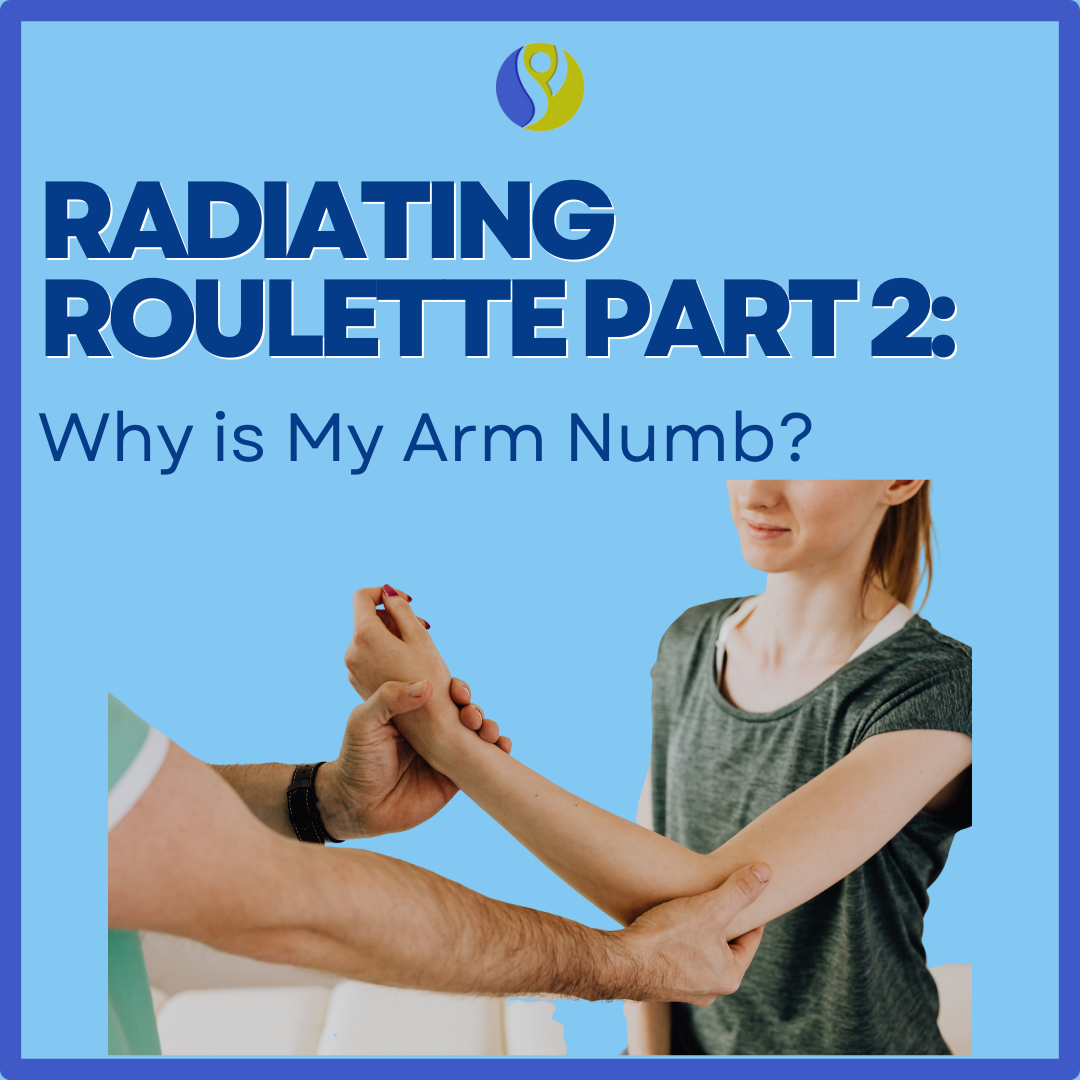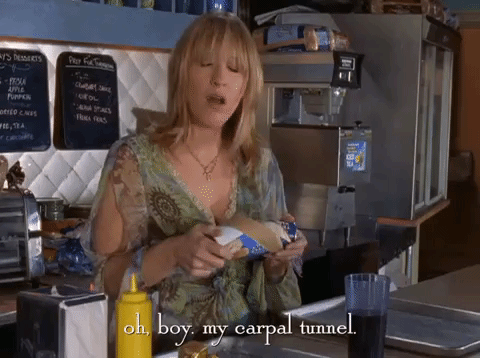Radiating Roulette Part 2: Why is My Arm Numb?
Radiating arm symptoms often arise from nerve compression (radiculopathy or entrapment), plexus irritation, or vascular compromise. We synthesize peer-reviewed evidence on cervical radiculopathy, carpal tunnel and cubital tunnel syndromes, thoracic outlet syndrome (TOS), plexus/neuralgic conditions, and rarer compressive neuropathies. Treatments range from conservative to surgical, based on severity and diagnosis.
Cervical Radiculopathy
Imagine your neck is hosting a nerve traffic jam where one of the bigwig nerve roots (say, C6 or C7) gets squeezed like toothpaste in a tube. That squeeze is cervical radiculopathy, a rebellious nerve root exits your cervical spine, takes one wrong turn into a disc herniation or osteophyte (bony overgrowth), and suddenly your arm feels like it’s auditioning for a horror movie. Like Jamie Lee Curtis, your nerves are screaming from sharp, burning, electric pain, and possibly even tingles, numbness, or weakness along its dermatome highway. en.wikipedia.org+15pubmed.ncbi.nlm.nih.gov+15aapmr.org+15.
How do we figure out it’s cervical radiculopathy? A classic exam move, Jackson’s test, involves bending your head to the side while a doctor gently pushes down on your head, if that recreates the arm pain..BINGO. Nerve irritation is confirmed en.wikipedia.org+1en.wikipedia.org+1.
Worst part? It’s often temporary. Around 75‑90% of cases improve with rest, PT (think traction and posture correction), and anti-inflammatories. No surgery is needed unless things go sideways, like persistent weakness or debilitating symptoms pubmed.ncbi.nlm.nih.govpubmed.ncbi.nlm.nih.govpubmed.ncbi.nlm.nih.gov.
So next time your arm screams “Hey, neck, what’s up?” Remember: it’s not ghost‑magic, it’s a compressed nerve root acting out auditions across your arm with electric flair.
Cause: Cervical spine disc herniation or spondylotic foraminal narrowing compresses nerve roots (C5–T1). Wikipedia+15PMC+15Reddit+15PMC+4PMC+4PMC+4
Symptoms: Sharp or burning radiating pain in dermatomal distribution; may include weakness and reflex loss. Cervical radiculopathy often mimics shoulder pain and distal neurologic symptoms. PMCLippincott Journals
Diagnosis: Combines clinical exam (e.g. Jackson’s Compression, Maximal Foraminal Compression ect.), EMG/nerve conduction studies, and MRI to confirm structural impingement. Lippincott Journals
Treatment:
Conservative: NSAIDs, cervical traction, physical therapy focusing on neck posture and range-of-motion exercises.
Interventional: Epidural corticosteroid injections.
Surgical: Indicated for persistent severe symptoms or neurologic deficits (e.g. ACDF or foraminotomy).
Carpal Tunnel Syndrome (Median Nerve Entrapment)
Imagine your wrist is a VIP tunnel beneath a nightclub, and the median nerve is the guest of honor. Only problem: the nightclub keeps getting crowd, packed by swollen tendons, inflamed tissues, or just plain bad architecture. That club is carpal tunnel syndrome (CTS). Carpal Tunnel Syndrome occurs when the median nerve gets squished between the carpal bones and the flexor retinaculum roof. Your thumb, index finger, middle finger ,and half the ring finger may start throwing a nerve tantrum with numbness, tingling, burning, or outright pain en.wikipedia.org+15pmc.ncbi.nlm.nih.gov+15reddit.com+15.
CTS affects about 3–5% of people globally, and women are roughly three times more likely to develop it. Blame anatomy (smaller tunnels) and risk factors like age, diabetes, obesity, pregnancy, and repetitive wrist flexion verywellhealth.compmc.ncbi.nlm.nih.govpmc.ncbi.nlm.nih.gov.
Think you can diagnose it by shaking your hand like a Polaroid picture? Close! Physicians rely on physical tests like Tinel’s tap test or Phalen’s maneuver—hold your wrists flexed for 30–60 seconds and see if the median nerve starts sounding alarms in your fingers en.wikipedia.org. And to really confirm the guest list, they may bring in the VIP screener: electrodiagnostic studies (EMG/nerve conduction), which can detect slowed nerve signals with high sensitivity and specificity pubmed.ncbi.nlm.nih.gov+10en.wikipedia.org+10verywellhealth.com+10.
Treatment typically begins with night splints, wrist stretches, and NSAIDs or steroid injections—you want to let that nerve chill before it demands eviction. If nothing improves after a few weeks or your thenar muscles start waving a white flag, carpal tunnel release surgery may be the final bouncer of peace health.com.
So next time your hand goes “Whoa, I’m crispy!” in the middle of typing or snoozing, just remember: it’s not witchcraft—just a nerve in a cozy tunnel desperately waving for elbow room.
Cause & Prevalence: Compression within the wrist’s carpal tunnel due to elevated compartment pressures from repetitive stress, tendon swelling, or anatomical variation. Affects ~10% of people over a lifetime. PubMed+15Wikipedia+15Reddit+15
Symptoms: Numbness, tingling, burning in thumb, index, middle, and half of ring fingers; often worse at night. Wikipedia
Diagnosis: Based on typical symptom patterns, Tinel’s/Phalen’s tests, confirmed with nerve conduction studies or ultrasonographic measurement of median nerve cross-sectional area. Lippincott JournalsWikipedia
Treatment:
Non-surgical: Night splints, corticosteroid injections, physical/occupational therapy. Guidelines support trying palliative treatments for 2–7 weeks before considering surgery. Wikipedia+1Reddit+1
Surgical: Cutting the transverse carpal ligament (open or endoscopic) is the only disease-modifying option for chronic or severe cases. PubMed+2Wikipedia+2Wikipedia+2
Cubital Tunnel Syndrome (Ulnar Nerve at Elbow)
Picture your elbow as a VIP tunnel for the ulnar nerve, known affectionately as the "funny bone" celebrity. When that nerve gets squished—thanks to holding your elbow bent against a hard desk, sleeping with your arm folded like a pretzel, or repetitive elbow flexion while gaming, your ring and pinky fingers start throwing tantrums: tingling, numbness, and awkward hand weakness that makes opening a jar feel like cracking a vault lock (and maybe even some tender elbow pain at the nerve’s exit ramp)Verywell Health+15Wikipedia+15Reddit+15.
Risk factors? Think diabetes, obesity, and "desk-hugging syndrome" (aka leaning on your elbow all day)Europe PMCWikipedia. Diagnosis often includes a friendly tap over the nerve (“hey, does that tingle?”), flexion-compression tests, and nerve conduction studies if things sound fishyVerywell Health+1IASP+1.
Most mild cases get better with elbow splints to keep you from turning into the Sleeping Elbow Contortionist, nerve glides, ergonomic changes, and NSAIDs. About half of people recover well without surgeryEurope PMCPubMed. But if things go south, such as developing persistent numbness, muscle weakness, or even atrophy, you might be ushered into minor surgery like in-situ decompression or ulnar nerve transposition (relocating the nerve so it can finally stretch its legs)PubMed+6PubMed+6Europe PMC+6.
In a nutshell: cubital tunnel syndrome is like your elbow filing a formal complaint against your arm posture. Time to let that nerve out of its cramped cubicle before your pinky gives up the ghost or at least stops being a loyal sidekick.
Cause: Compression at the elbow’s cubital tunnel is commonly due to elbow flexion or direct pressure. PMC
Symptoms: Numbness or tingling in ring and little fingers; weakness in grip or finger coordination.
Diagnosis: Tinel’s sign at the elbow, nerve conduction studies to localize entrapment. PMC
Treatment:
Conservative: Night elbow splints (preventing flexion), ergonomic adjustments, NSAIDs.
Surgical: Ulnar nerve decompression or transposition if symptoms are persistent, severe, or progressive.
Thoracic Outlet Syndrome (TOS)
Imagine your collarbone teamed up with your first rib to form an overly aggressive nightclub bouncer team guarding a VIP passageway called the “thoracic outlet.” The brachial plexus nerves (and sometimes blood vessels) try to slip through, but poor posture, tight scalene or pectoralis minor muscles, or even a surprise extra rib can clog the door. These VIP guests then stage a protest: numbness, tingling, or heaviness in your arm or hand—often hitting the little two fingers hardest—or the arm might turn blue, swell, or feel icy if vascular passageways are blocked. Most cases—nearly 95%—involve nerve compression (neurogenic TOS), especially when you fling your arms overhead or slouch at your desk all day. Diagnosis is like a bizarre dance: doctors perform the Adson or Roos maneuvers, order imaging or EMG/nerve tests, and sometimes inject numbing meds into tight muscles to see if the symptoms retreat. Treatment starts with physical therapy—stretching, posture fixes, strengthening, maybe nerve glides—and only escalates to Botox injections or surgery (like removing the first rib or scalene muscle) if the VIP nerves keep getting stuck.
Prevalence & Anatomy:
Neurogenic TOS (nTOS) accounts for 90–95% of cases are caused by compression of C5–T1 roots in the scalene triangle, costoclavicular space, or under pectoralis minor. PMC+1Reddit+1
Vascular TOS variants: venous (effort thrombosis) and arterial (embolism). PMC+1Reddit+1
Symptoms:
Neurogenic: Neck/shoulder pain, numbness/tingling (especially in fingers), weakness, positional exacerbation. Reddit+8PMC+8Lippincott Journals+8
Vascular: Swelling, cyanosis (venous) or coldness, pulses issues and risk of digit ulcers (arterial). Reddit+3PMC+3Wikipedia+3
Diagnosis:
Selective physical maneuvers (Adson's, Roos/EAST, Tinel at plexus), Doppler ultrasound, MRI or MR neurography. PMC
Treatment:
Conservative: Postural education, PT/Chiro targeting scapular and scalene muscles, stretching, NSAIDs. Botulinum toxin into muscles may help in nTOS. PMCPMC
Interventional: Thrombolysis/anticoagulation for venous TOS; embolectomy plus decompression for arterial. Wikipedia+6PMC+6PMC+6
Surgical: First rib and/or cervical rib resection with scalenectomy for refractory or vascular cases. PMC
Brachial Plexus Neuritis & Other Entrapment Syndromes
Your brachial plexus are nerves that sprint from your neck to your fingertips—as a rock band suddenly without warning: the lead guitar (your upper arm nerves) blares out in pain, the drummer (your shoulder muscles) goes silent, and the keyboardist (your hand) starts fumbling its tune. That’s brachial plexus neuritis—also known as Parsonage–Turner Syndrome—where a mysterious immune misfire (often after a virus, vaccination, or surgery) sparks searing shoulder pain for days to weeks, then leaves weakness and numbness as the encore. The good news? Most people slowly regain function over months to a couple of years, often just with pain meds and physical therapy verywellhealth.com+14aafp.org+14princetonsjc.com+14.
But wait, there’s more! Your arm is full of tiny tunnels that love trapping nerves like uninvited party crashers. There’s the radial tunnel squish (forearm pain mimicking tennis elbow), pronator teres syndrome (median nerve pinched in the forearm), anterior interosseous syndrome (median nerve branch causing motor loss without feeling), Guyon’s canal (ulnar nerve at the wrist), suprascapular nerve entrapment (shoulder pain in overhead athletes), and classic cubital tunnel syndrome (ulnar nerve at the elbow) to name a few. en.wikipedia.org.
So in short, brachial plexus neuritis is like your nerve bundle caught in an unexpected lightning storm. Pain first, then weakness, then slow recovery. The other entrapment syndromes are more like cramped backstage passages: if the nerve doesn't fit, it makes a fuss with tingles, numbness, or odd muscle behavior.
Parsonage–Turner syndrome: Sudden-onset severe shoulder pain followed by muscle weakness. It’s inflammatory and self-limited. PMCPMC
Suprascapular nerve entrapment: Common in overhead athletes; presents with ambiguous shoulder pain and infraspinatus weakness. Lippincott Journals
Radial tunnel syndrome: Posterior interosseous nerve compression at the elbow causes forearm pain without sensory loss. Wikipedia
“Double Crush” & Differential Diagnosis
Compression may occur at multiple sites (e.g., neck + wrist), known as “Double Crush Syndrome.” However, combining CTS and TOS is uncommon (<1%), and co-occurrence should be evaluated carefully. PubMed+1Reddit+1
Relevant alternative diagnoses include: shoulder pathology, systemic disease (e.g. vasculitis), tumor, or thoracic spinal issues — often differentiated via exam/imaging. PMC
🛠️ Treatment Summary Table
🔍 Clinical Pearls
Start broad: Use exam + imaging + neurophysiology (EMG/NCS) to differentiate root vs. peripheral compression. Reddit+1Wikipedia+1WikipediaPubMed+2Wikipedia+2Wikipedia+2
Posture matters: Especially for TOS and radiculopathy; PT/Chiro targeting neck posture and scapular stabilization can prevent progression. Reddit+15PMC+15Reddit+15
Treat adaptively: Non-surgical management resolves most cases; reserve surgery for significant weakness, atrophy, vascular compromise, or chronic pain.
Consider All Options: Wrist pain alone isn’t always CTS; shoulder/neck sources or tendonitis may be the culprit instead. RedditWikipedia
🧾 Conclusion
Radiating arm pain, numbness, and tingling stem from various well-described compressive or inflammatory neural syndromes. Accurate diagnosis, supported by exam, imaging, and electrodiagnostic testing is key for finding the root cause of your condition. Conservative care resolves most, but timely recognition of red flags (e.g. vascular signs, progressive weakness) ensures intervention before permanent damage occurs.






